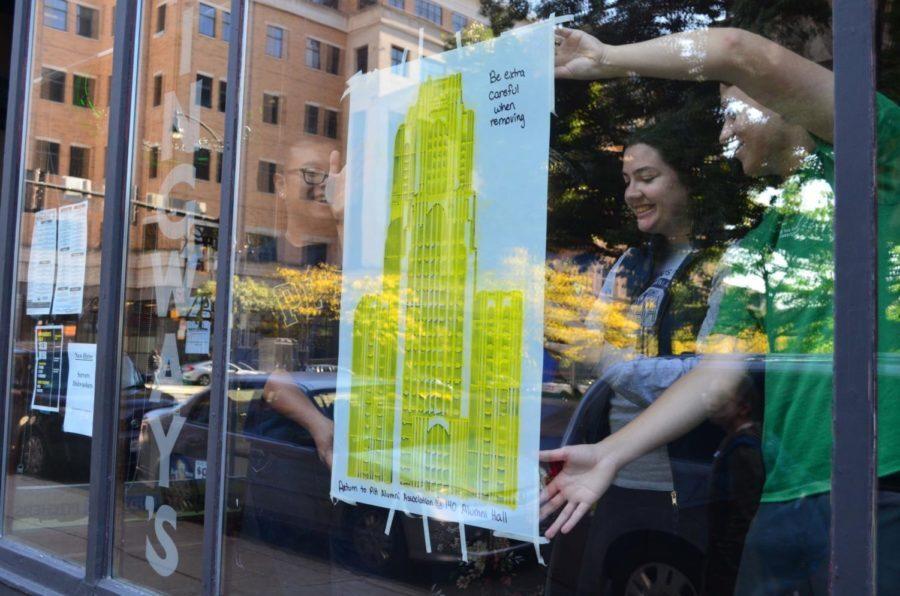‘A special time’: Pitt alumni reflect on homecoming traditions throughout history
Students participate in Paint the Town in 2019.
October 5, 2022
For Valerie Njie, Pitt’s homecoming celebrations aren’t just a chance for students to party and watch the football game. Instead, it’s a chance for alumni to connect with students and reconnect with old friends.
“It’s a time to bond and meet up with old friends, fellow students, and you meet so many new people,” Njie, a former president of the Pitt Alumni Association and current Board of Trustees member, said.
Pitt’s homecoming started in 1928, although it became more popular when Pitt played Ohio State University in 1929. The earliest homecomings often involved students hanging out in fraternities and smoking cigarettes during “Open House Smokers.” The celebration took a break in the 1940s at the start of World War II, but when it returned in the 1950s, the University introduced a homecoming court and a parade with floats crafted by Pitt sororities and fraternities.
At her first homecoming in 1968, Njie fondly remembers interacting with new people at parties and football games.
“It was thrilling. I didn’t know what to expect. But it was a lot of parties and the games were a big thing,” Njie said. “Everybody went to the game and just a lot of parties and it was just so exciting. Other schools would come in. So we got to interact with some new people, and then we would repay them by going to their homecoming.”
Helen Bowers, a Pitt alumni who graduated in 1992, said she didn’t attend many events for homecoming in school. She said if there were a lot of events, they weren’t as heavily advertised as the main tailgating, football game and homecoming court. She also encouraged students and alumni to attend events that the African American Alumni Association will host this week.
“As a student, [they had] homecoming court. That was big. So that was the big draw as a student, voting for a homecoming queen and king and they go into the game to see who won, but that was that was it,” Bowers said.
Over the past few years, the Alumni Association has worked to create a plethora of events for both students and alumni according to Rick Antolic, Pitt’s alumni coordinator. Some events include a talk on Thursday with former Pitt football player Tre Tipton and the Blue & Gold Bash on Friday.
“It offers us many great opportunities to bring the student body and alumni body together, and to get them networking and hopefully make connections for the students that will last a lifetime,” Antolic said. “And so when they network professionally, with alumni, and they get into those companies and organizations that other alumni are in, that benefits them as well.”
When Njie attended Pitt in 1968, she said the University lacked many resources for Black students. She said she was one of 50 Black students enrolled through “Project A.” By 1992, Bowers said conditions for Black students improved, but still weren’t sufficient.
“One time I was working with the Black Action Society — and we didn’t have a lot of student groups and everything like it is now,” Bowers said. “What we did was we would interview Black students for homecoming queen and king. We would choose one each, and then we would support them as a whole unit to make sure that they got on the court.”
Njie also said the concept of a homecoming “queen” and “king” is “discriminatory” toward non-binary students, and Pitt has worked to replace these titles with something more gender-neutral. In place of homecoming court, Pitt gives two students who show a strong sense of pride and involvement in the Pitt community “Spirit of Pitt” awards.
While homecoming has evolved over the years, Njie said many traditions have stayed the same. Pitt still has a firework display on Friday night, a Saturday football game and tailgating. According to Njie, alumni being able to come back to Pitt is very essential.
“It really is a special time that almost makes you feel like you’re a college student again, when you see old faces, when you look and see some of the exciting things that are happening on campus now,” Njie said. “Let’s say you went to school, like myself, I graduated in ‘71 or even if you graduated in the year 2000, when you come back, this is a different place.”
Not only is it important for students and alumni, but for the University itself, Bowers said.
“I think the idea of homecoming is very important for the University, because that’s an opportunity for the University to showcase what they’ve done, what they’re doing, the progress they’re making,” Bowers said.
Correction: This article originally said Njie was one of only 50 Black students at Pitt. However, she was one of only 50 Black students in Project A. The Pitt News regrets this error.








